ACEHE is a new manufacturer slowly making its first steps into the European market. This review looks at the new ACEHE 4S 1300 mAh pack, which features a 75 C rating and an interesting cable terminal.
Appearance
The new ACEHE 4S 1300 75C* (by the way I some how struggle to pronounce this brand name) battery comes in a dark green shrink wrap. There is a lot of foam in the front protecting the cells. The stickers claims a 75 C rating. One thing you directly notice: Instead of routing the wires to the edges of the pack, the ACEHE battery has main wires as well as balancer leads coming out right in the middle. It looks different, but somehow makes sense.
Technical Design
The ACEHE 4S 75 C pack* is a standard 4S1P config flight pack for high power use.
Build Quality: Very good. Pack feels very well made on the outside. Connection terminal looks solid.
Plugs: The Dinogy pack comes with standard XT60 connectors* equipped. XT60 comes protected with a cap for transport and a valcro strap for mounting.
Cables: ACEHE uses 12 AWG wires on this packs. The high flexible silicon layer is rated up to 200°C. Cable length is about 11 centimeters, which is almost too long for my applications
Balancing plugs: Standard XT-system. Balance wires are very short (>3 cm) which is a benefit in terms of getting them out of the prop-range on the aircraft. Main power line and balancer wires are connected right at the center of the pack.
Technical Details
| Manufacturer | ACEHE* | 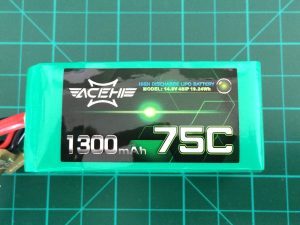
(Click to enlarge.) |
| Type | ACEHE 75 C | |
| Cell chemistry | LiPo | |
| Cell type | ACEHE | |
| Cell count | 4 | |
| Pack configuration | 4S1P | |
| Capacity | 1300 mAh | |
| Max. Charge Current | ? | |
| Max. Discharge Current Continuous Burst |
97,5 A ? A |
|
| Weight w/o plugs with plugs |
– ca. 154 grams |
|
| Measurements as listed measured |
30 x 32 x 70 mm 35.1 x 34.5 x 74 mm |
|
| Price | 27.95 € | |
| Dealer | Amazon.de* | |
| Note | This battery has been directly donated by the manufacturer / distributor for review purposes. |
Break-in documentation
The battery followed the standard break-in-process: The pack is charged at a rate of 1C until CV-phase ends with current of 1/10C. The break-in phase consists of four charging cycles at 1C and four corresponding discharges at 1 C / 4C / 10C and 20 C.
Anomalies: No anomalies during break-in.
Internal resistance measurements during break-in phase
| Cycle | Cell 1 | Cell 2 | Cell 3 | Cell 4 | Total |
| After first charge | 8.8 | 7.9 | 9.3 | 9.0 | 35.0 |
| After second charge | 8.6 | 7.9 | 9.2 | 8.9 | 34.6 |
| After third charge | 8.8 | 7.0 | 7.7 | 7.7 | 31.2 |
| After fourth charge | 8.7 | 7.0 | 7.8 | 7.7 | 31.2 |
Charging process
CV-Phase is relatively short on this cell type. Balancing in normal mode took only 2:21 min. Cell drift during charge was unobtrusive. This is for 1C charge (1,3 A).
Load Testing
The main part of this battery test will consists of different load test settings showing the battery performance. Constant load testing is used to judge the advertised C-ratings as well as look at cell drift under high loads. We also check on internal resistance once more. Next up is the dynamic current test, which simulates a „real“ flight with changing (=dynamic) loads. For test methodology please check the dedicated methodology page!
Constant Load Testing
Constant load testing follows a certain load pattern of different constant currents. Base load is 10 C. Current pulses at 50 C, 35 C, 20 C and 30 C are maintained for time intervals between 10 and 20 seconds. For more details please refer to the test methodology page.
Capacity Usage
During this test the pack delivered 933 mAh. This is 71,8 % of nominal capacity. A very good result.
Average cell voltages
The following table lists the average voltages per cell, of the total pack, as well as the averaged value per cell as fraction of total voltage during phase of active load.
| Cell 1 | Cell 2 | Cell 3 | Cell 4 | Total | Average per cell | |
| Avg. Voltages | 3.740 V | 3.744 V | 3.746 V | 3.741 V | 14.971 V | 3.743 V |
Just looking at average values the ACEHE pack* performs good. All cells stayed well above 3,7 V on average. A value of 3.75 V / cell can be considered very good. The pack comes close.
Focus Voltages
Exceptionally interesting when testing a battery under a constant load for a longer period of time: the lowest voltage per cell just before load impulse is disabled. On top, you should have look at voltage recovery rate, that is: how fast do cell voltages rise again once load impulse is cut.
| Phase | Cell 1 | Cell 2 | Cell 3 | Cell 4 | Total |
| End of 50 C | 3.533 V | 3.534 V | 3.542 V | 3.58 V | 14.189 V |
| End of 35 C | 3.524 V | 3.531 V | 3.51 V | 3.552 V | 14.148 V |
| End of 20 C | 3.258 V | 3.293 V | 3.347 V | 3.295 V | 13.193 V |
| End of 30 C | – | – | – | – | – |
The average cell voltage stability on the ACEHE pack can be considered good. No cell dropped below 3,5 V benchmark during the first two current pulses.
Average voltage recovery per second
Those values are specific to the test setting and not valid for the pack in general! Still they allow an estimated guess about how fast voltages rise again after current spikes.
| Cell 1 | Cell 2 | Cell 3 | Cell 4 | Total | |
| Avg. Recovery | 0.0383 V / s | 0.0381 V / s | 0.0364 V / s | 0.031 V / s | 0.144 V /s |
The pack shows low voltage drops and fast recovery rates when switched from current pulse to base load.
IR-Measurement
IR measurement is conducted using the four current pulses. Resistance for each cell is calculated in all four discharge phases. Shown values are averaged to cancel out different temperature points due to different discharge states during measurements.
| Cell | 1 | 2 | 3 | 4 | Total |
| Resistance [mΩ] | 3.23 | 3.09 | 2.86 | 3.06 | 8.98 |
Interpretation: The internal resistance of 3.06 mΩ average per cell indicates a „true“ C-rating of around 39 C (50.5 A). This is on the conservative side and represents a current draw that will make the pack last for a long time. The pack had no problems delivering during high C discharge pulses. The cells seem to be matched good – cell 1 lags a little behind, though. Constant performance of 39 C is solid in this capacity class.
Cell drift under load
| Discharge Phase | 50 C | 35 C | 20 C | 30 C |
| Max Cell drift (V) | 0.017 V | 0.033 V | 0.089 V | – |
Cell drift is very low on this ACEHE battery*. Even to the end of the discharge cycle the cells stick closely together!
Key Temperature Facts
Temperature Development
All temperature probes reported values below cut-off point at 58°C. Max. temp during discharge was around 50.6 °C on top of pack. Note that heating of stressed LiPo packs will continue for some more time even when load is cut.
Market Comparison
The following chart shows all reviewed LiPos in the same product segment for direct comparison of performance. Higher values under load are better.
Constant 25 C Discharge
Pretty much a standard benchmark in the LiPo industry.
Cut-Off /warning value for this battery should be chosen 3,45 – 3,5 V minimum. After this point voltage drops very quickly. The battery provided 925 mAh (71.2 %) during the 25 C discharge. A good value again.
Market Overview
Comparison of different reviewed 1300 mAh batteries under 25 C load.
Dynamic Load Testing
The dynamic load testing setting consists of two separate discharge scenarios that have been developed of two different real-life FPV flights. Pattern one represents a high speed low proximity flight around the open field with some hovering to the end. Average load is around 22 A. Second pattern is a free-style flight around trees in the park with some current spikes near 70 A. Average load on this flight is around 13 A due to longer floating periods.
Capacity Usage
During the test of pattern 1 the pack delivered 917 mAh. This is 70.5 % of nominal capacity. A very good result. In patter 2 testing 933 mAh (71.8 %) could be used before first cell reached cut-off voltage.
Market Comparison
The following charts give an overview of all tested packs in the 1300 mAh class so far.
The last chart of this review sums up the usable capacity during all four load scenarios. Please note that this is only the capacity consumed by the electronic load! There are losses due to heating of the pack, which could be approximated (see testing methodology page). All four tests are cut when any cell goes below cut-off voltage of 3,3 V (or pack goes above 58 °C on any of the three probes). If you would push further and go down to 3,0 V/cell you will be able to squeeze out some mAh more, but at the cost of excessive heat generation and shortening of pack life-span. This value will most likely differ from what you get when flying on a quad as most people don’t monitor voltage on a per cell basis and therefore don’t even notice if voltage drops below 3,3 V/cell during punsh-outs (what’s not necessarily a good thing, though). For comparison, used capacity until 3,3 V/cell is reached is the base line in all battery reviews on Drone-Zone.de.
Conclusion
The ACEHE 4S 1300 mAh 75 C* battery is the new player around the block. It’s a usual sized pack with a capacity to weight ratio of 8.44 mAh/g. Build quality of this battery is very good. The pack is rectangular shaped and keeps it shape under every load situation. No puffing what so ever! After working with it for some time I personally like the new design approach, having the power leads coming directly out in the middle of the front. Voltage stability is very good on the ACEHE pack. Cut-off should be chosen at 3,45 V / cell minimum. Usable battery capacity is good average. Of course, it won’t beat any graphene based batteries. Cell matching is good. The very low cell drift even under high constant loads needs to be pointed out. The rating of 75C is a little over the top, of course. I would rate this pack at still respectable 39 C continuous. This allows you to pull around 50 A without having to worry about the packs health too much. An strong value and nothing you would ever have thought of two or three years back when talking about 1300 mAh class batteries. As you can see in the dynamic loads higher current spikes are handled well, too. For around 28 € this pack is certainly not the cheapest battery you can buy, considering the performance. But if you are in to try something new, you won’t go wrong by picking up a ACEHE product*. The very low cell drift and good cell matching let you hope that the ACEHE* pack will age evenly across all cells and give you strong performance even for the upcoming seasons.
Other batteries in this capacity class:



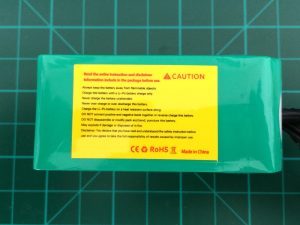
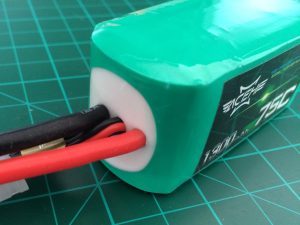
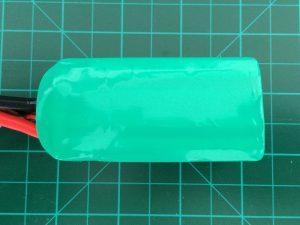
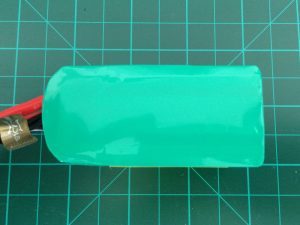
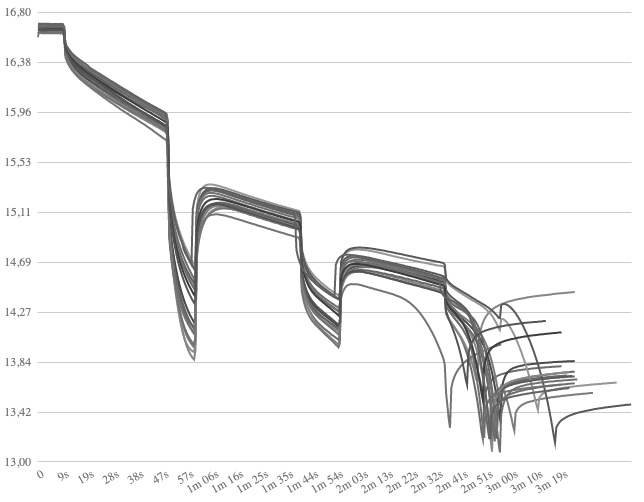
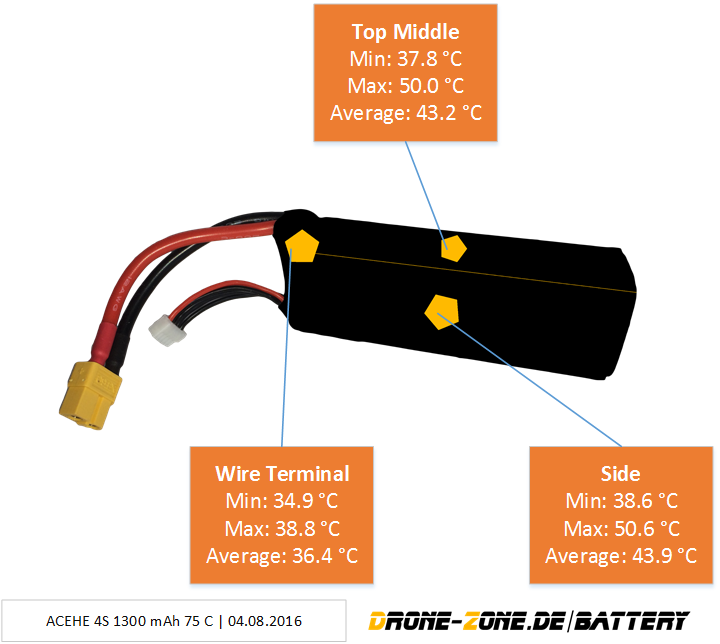

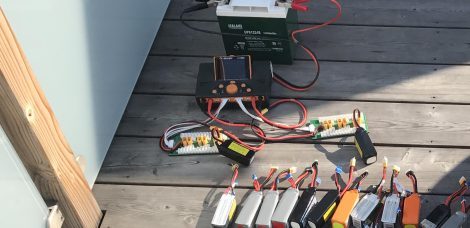
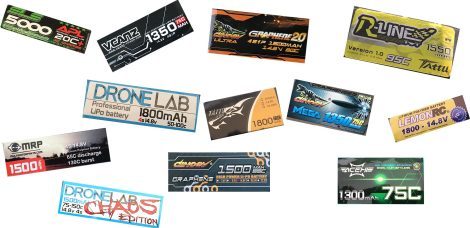
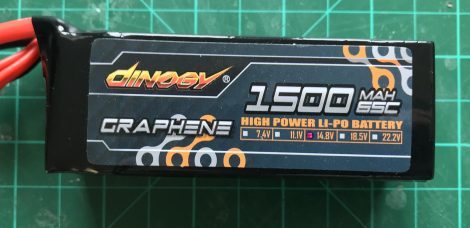
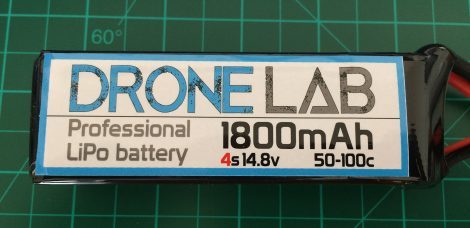

Thank you for your complete and insightful test and explanation on this battery. It has been very useful for me to try this brand of battery for my 1/8 buggy (15,2V/5200mAh/50C). I hope it passes my test also!! ;-)